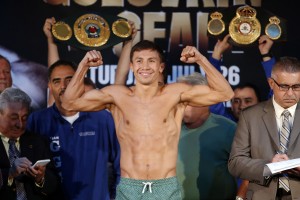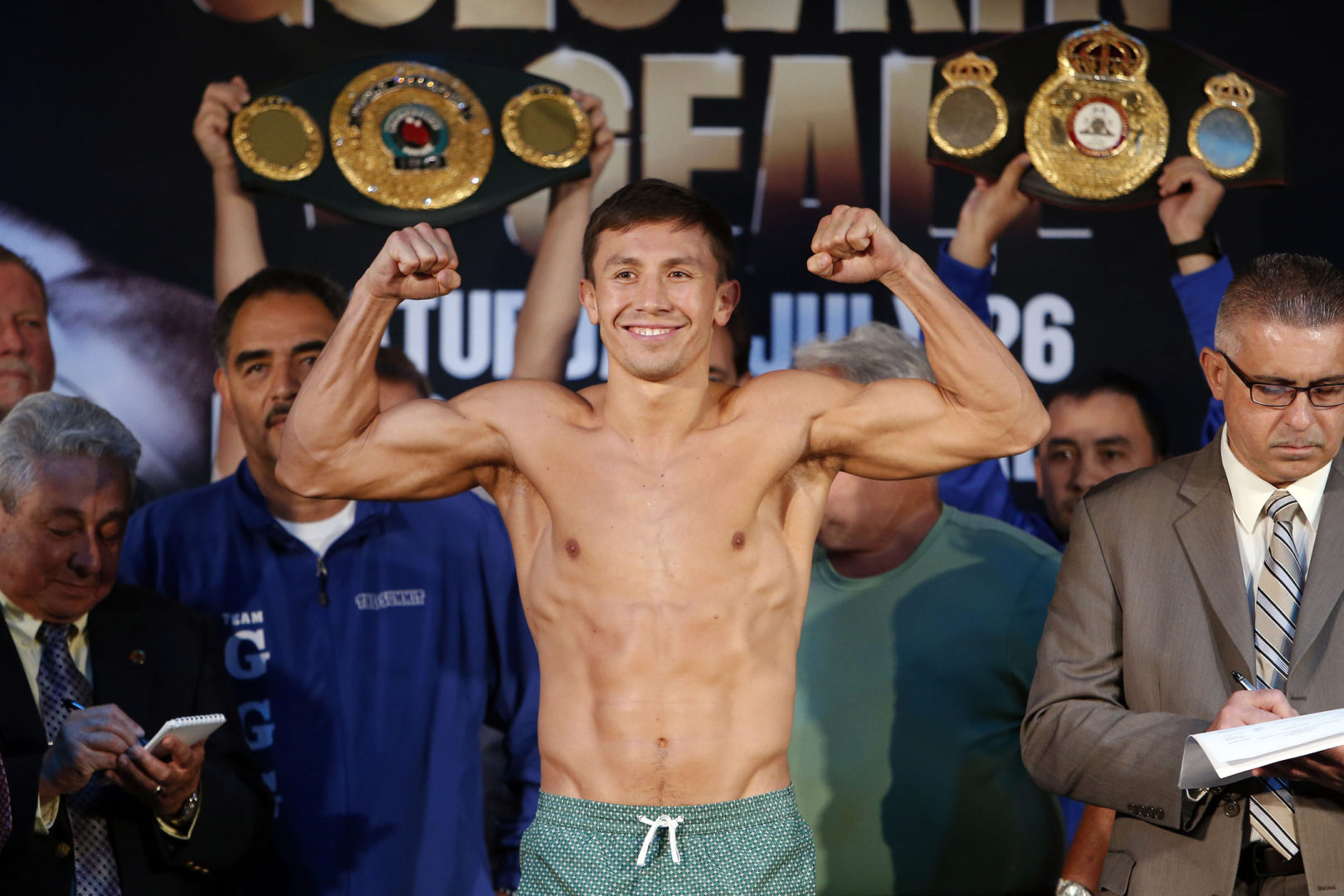By Bart Barry-

“Geale had the best credentials of anyone that’s gotten in the ring with him. Geale is a former two-time titlist.” – Gennady Golovkin’s promoter Tom Loeffler, July 26.
Saturday at Madison Square Garden, 32-year-old Kazakhstani middleweight titlist Gennady “GGG” Golovkin stopped Australian challenger Daniel Geale at 2:47 of round 3. It was another attraction-building event televised by HBO, a portentous sort of happening intended to entice viewers with the chance one of Golovkin’s next three or four matches might come against enticing, or at least appropriate, competition – even if a $60 pay-per-view tariff must be levied upon subscribers to see it.
Daniel Geale fought like a self-taught hobbyist, Saturday, a man who wanted out of his contract during introductions and was unheard of in the United States for good reason until last week, when aficionados who know better began exercising their minds with the calisthenics of thought-experiment, proving they possessed dexterity enough to imagine a means by which Geale might vanquish Golovkin. Geale was, after all, the guy some Americans watched via buggy videostream in 2012 decision Felix Sturm, a middleweight titlist still better known by Americans for being wronged during a De La Hoya-Hopkins infomercial 10 years ago than anything he achieved afterwards.
There is some simple calculus in matchmaking, to complement its much more difficult intuiting, and that is: Volume punchers solve boxers who solve power punchers who solve volume punchers. That’s an indirect way of saying a volume-punching guy like Geale – who unloaded his best righthand on an onrushing Golovkin in round 3, and landed it flush, and didn’t so much as compromise the trajectory of Golovkin’s own righthand, an already started one stiff enough to land Geale on a blue mat from which the Aussie rose with seven beats to go in a 10-count he then stretched to a standing 4-count before quitting on his feet with a spiritless shake of the head – was a better showcase for Golovkin than even cynics anticipated.
Here’s a direct way of putting it: Daniel Geale hadn’t a prayer against Gennady Golovkin. Much of that is Golovkin’s fantastic professionalism, a professionalism supporter and dissenter alike would dearly like to see tested by a worthy adversary, more overdue for Golovkin now than any HBO fighter since Andre Berto, but a goodish amount of it is also due to matchmaking and Geale-promoter Gary Shaw’s noteworthy penchant for getting no-hopers on HBO.
If there was a first noteworthy moment in Saturday’s main event, it came in the final seconds of round 1, when Golovkin measured Geale with straight rights. What made it noteworthy was Golovkin’s fearlessness across from Geale, a fearlessness that allowed Golovkin to paw and tap with a right glove extended fully from his chin even while he remained in an orthodox stance. Youngsters are taught to time and punish opponents who hang their jabs, returning their lead heads at half the rate they deploy them, but how often does a prizefighter in a title match have the chutzpah to hang a cross, and leave it there?
That it took fewer than 170 seconds for Golovkin to realize Geale’s freshest haymaker mightn’t imperil him speaks to matchmaking, finally, more than another element. Once the man across from you is incapable of hurting you, he becomes a target, not an opponent, and while reducing challengers to such marks a champion’s greatness, having opponents ready-reduced in round 1 is a mark of attraction-building more than matchmaking.
Talk now turns to a Madison Square Garden superfight between career welterweight and new middleweight champion Miguel Cotto and Golovkin, which, conducted at a catchweight between 155 and 155 1/4 pounds, would be compelling. Such a fight, though, loses its attraction by 30 percent with every pound that happens above 155 – still, technically, middleweight – since the men’s styles are similar enough to reduce their competition to one of size, and Golovkin would be considerably larger. Cotto, of course, graduated beyond the Daniel Geales of the world almost 10 years ago, when he stopped Randall Bailey (26-2, 24 KOs) in 2004, and Cotto is only 18 months older than Golovkin – which ought to help statisticians recalibrate the meaningfulness of Golovkin’s 90-percent knockout ratio.
If the best match for Golovkin is at junior middleweight with the middleweight champion of the world, or at middleweight with a man enjoying a career rebirth round 154 pounds, so be it, but can we please cool the silly banter about GGG’s willingness to fight great men at 168? Golovkin has fought exactly two times above middleweight, when he defeated Amar Amari and Malik Dziarra in 2008, and to say his Saturday untethering of Daniel Geale qualifies him for a match with Carl Froch or Andre Ward at super middleweight is, frankly, inappropriate.
The same night in 2009 Ward unmanned Mikkel Kessler, a favorite to win the Super Six tournament, Golovkin laid waste to Mikhail Makarov in Makarov’s 11th prizefight. Two weeks before Froch gave Lucian Bute his first career loss, in 2012, Golovkin stamped Makoto Fuchigami’s record with its seventh. The question, then, is not if Ward and Froch would each be 30-0 against the 30 men Golovkin has faced but instead: Would either Ward or Froch have less than a 100-percent knockout ratio?
A hundred victories over Daniel Geale do not approach one victory over Andre Ward, and a thrashing of little Miguel Cotto, asked by many to retire 4 1/2 years ago when Manny Pacquiao whupped him, does not approach so much as a decision victory over Carl Froch. It’s long past time for Golovkin’s handlers to do something bold.
Bart Barry can be reached at bart.barrys.email (at) gmail.com











